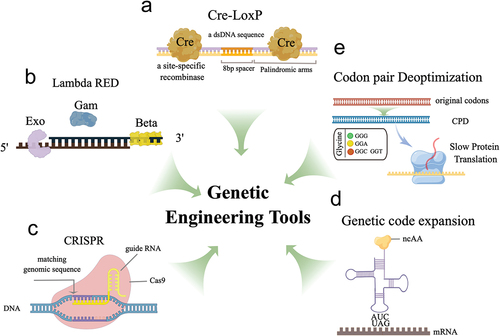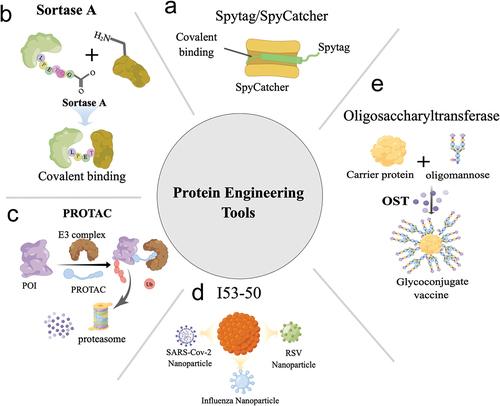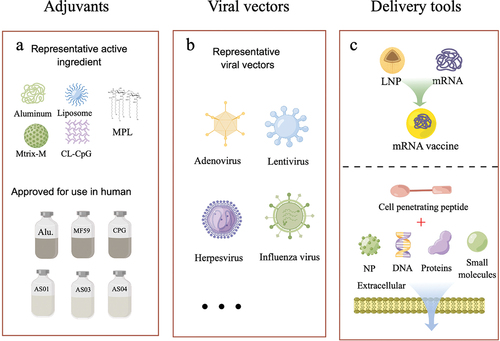Figures & data
Figure 1. The diagram illustrates the working principles of several genetic engineering tools used in vaccine development. (a) Cre recombinase specifically recognizes LoxP sites to achieve site-specific gene recombination, allowing for the creation of conditional knockouts or gene expression modulation. (b) the λ Red system comprises three proteins, including Exo, Beta, and Gam, and functions to promote homologous recombination for gene editing. (c) CRISPR-Cas9 genome editing utilizes purified Cas9 and sgRnas to target and modify specific genomic sequences. (d) Genetic code expansion is a tool that employs specific aaRS/tRNA pairs to introduce unnatural amino acids into the genetic code, which can be used for antigenic modification or virus attenuation. (e) Codon deoptimization strategies utilize suboptimal codons to reduce protein translation efficiency, resulting in effective virus attenuation. These genetic engineering tools offer a range of possibilities for modifying genetic sequences, from small-scale modifications to large-scale genome editing, and hold great potential for vaccine applications. The schematic illustration was drawn using Figdraw tools (www.figdraw.com).

Table 1. Summary of molecular engineering tools.
Figure 2. A schematic representation of the working principles of various protein engineering tools. (a) the SpyTag/SpyCatcher system utilizes intramolecular natural isopeptide bonds to enable covalent linkages between molecules. (b) Sortase a recognizes distinct motifs and mediates the covalent attachment of protein molecules. (c) PROTACs are a category of molecules that recruit E3 ubiquitin ligases to target proteins, resulting in their ubiquitination and subsequent degradation by the proteasome system. (d) I53–50 functions as a platform for developing multiple nanoparticle vaccines by displaying antigens on their surface. (e) Oligosaccharyltransferase possesses the capacity to covalently bind natural polysaccharides to specific sites on carrier proteins, streamlining the preparation of glycoconjugated vaccines. These protein engineering tools offer a spectrum of possibilities for modifying proteins, from small-scale modifications to extensive protein conjugation and vaccine production, holding substantial potential for future research and clinical applications. The schematic illustration was drawn using Figdraw tools (www.figdraw.com).

Figure 3. The schematic diagram illustrates several widely used vaccine research tools in recent years. (a) the active ingredients of adjuvants and their approved use in humans are depicted. (b) Viral vectors serve as a popular tool for delivering antigens to the immune system, with various viral vectors developed and in use. (c) Lipid nanoparticles (LNPs) have emerged as the most commonly used tool for delivering mRNA-based vaccines. Additionally, the use of cell-penetrating peptides has been explored to improve the cellular uptake of various molecules, including antigens and adjuvants. These vaccine research tools offer unique advantages for vaccine development, and their continued development holds great promise for enhancing the efficacy of vaccines against various diseases. The schematic illustration was drawn using Figdraw tools (www.figdraw.com).

